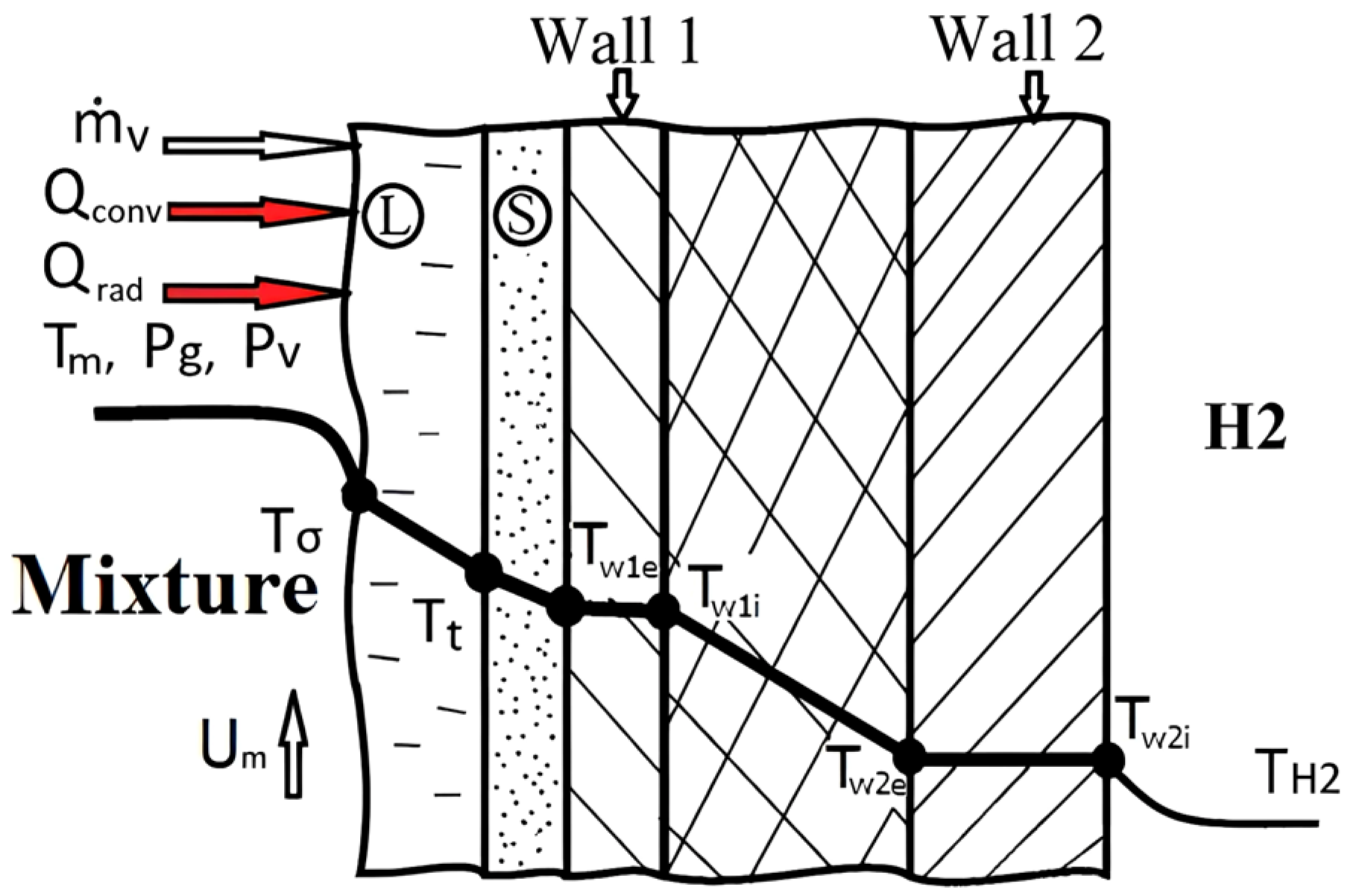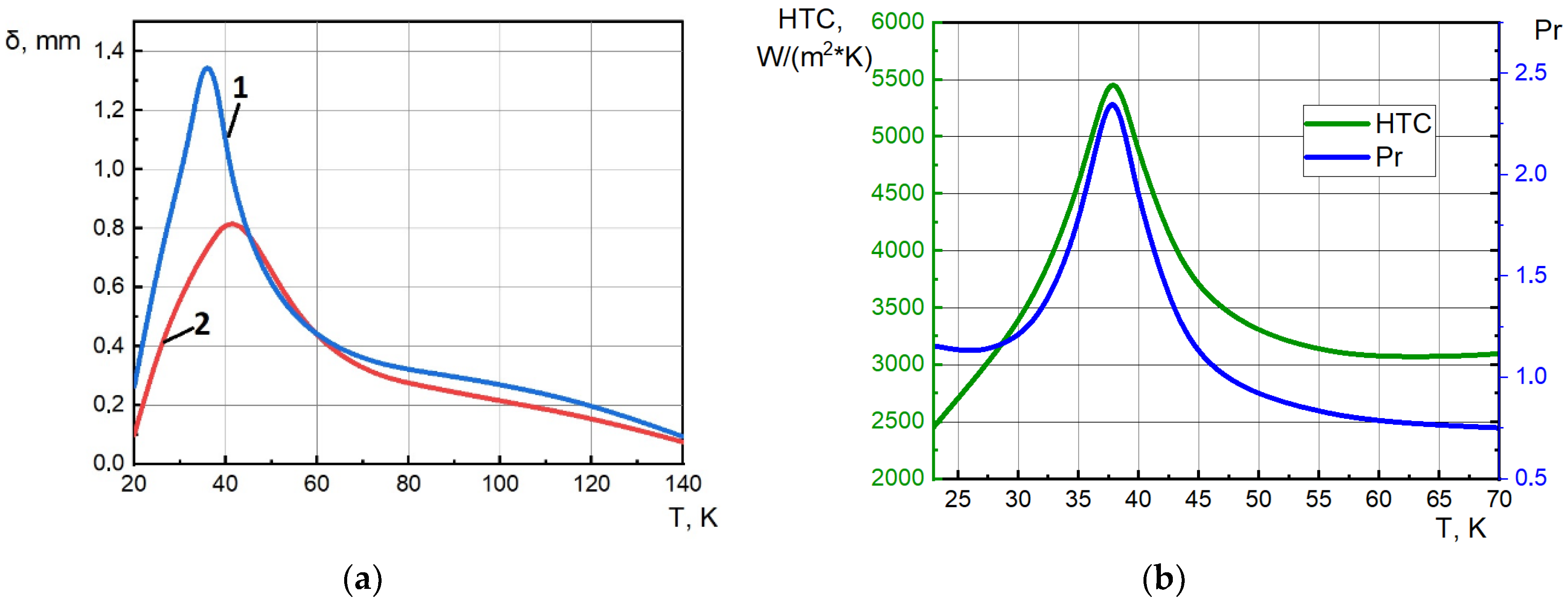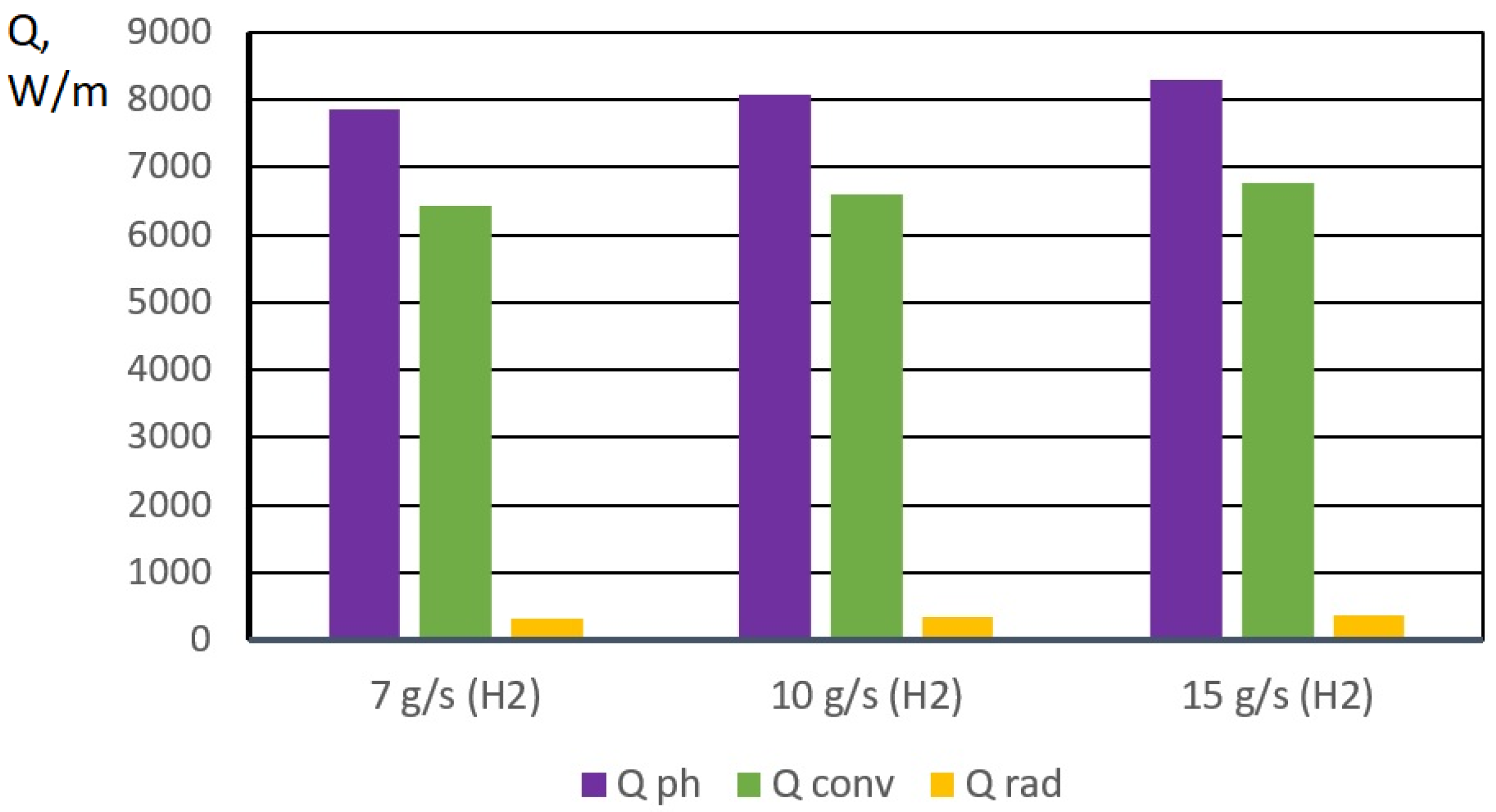1. Introduction
When the vapour–gas mixture flow heats the cold walls of a heat exchanger, a condensed phase (solid and liquid) may precipitate on these walls. Such conditions can occur in the fuel supply system of a hydrogen aircraft engine. In the case of liquid hydrogen (LH2) heating by exhaust gas, not only H2O, but also N2, O2, etc., can precipitate on the heat transfer surface. As a result, the roughness and thermal resistance of the heat exchanger walls increase, and the cross-section of the vapour–gas mixture flow decreases. In critical cases, solid-phase crystals can even damage structural elements.
Heat and mass transfer processes, which occur during condensation and the subsequent crystallisation of moisture on supercooled surfaces, were examined in studies [
1,
2,
3,
4], focusing on aircraft icing issues. The Navier–Stokes equations of a viscous compressible gas were used in these studies to calculate the airflow parameters. The authors of [
5] incorporated various models of heterogeneous media mechanics for droplet movement. Nevertheless, insufficient attention is paid to the heat exchange processes near a cold surface.
Film condensation is a common phenomenon in phase change heat transfer. Experiments on R134a vapour condensation on the cooled horizontal tube are presented in [
6]. A theoretical study on the condensed film flow on a horizontal pipe with suction effects on the surface is presented in [
7]. A lot of attention is paid to condensation issues, including heat and mass transfer during condensation in the presence of a noncondensable gas [
8,
9] and atmospheric water vapour condensation on surfaces [
10]. Here, water vapour is usually in the condensing phase, and the subsequent crystallisation of moisture is not considered. There are practically no studies on the condensation of N
2, O
2, etc.
Both classical approaches [
11,
12] and the relationships obtained based on modern experiments [
13,
14] are used to describe a coupled heat transfer process. However, there is no single and generally accepted approach to model thermohydraulic processes during condensation and the crystallisation of the condensed phase on the heat exchanger walls. While cryogenic heat exchangers are typical components of the aircraft fuel system [
15], hydrogen liquefaction plants [
16], and industrial installations [
17], the questions of condensed phase formation and the icing of surfaces as a result of cryogenic liquid heating are not sufficiently studied and require further research.
2. Methodology
This study aims to improve a model of thermohydraulic processes in the heat exchanger during condensed phase precipitation on its cold surfaces. The process under analysis foresees a simultaneous formation of a multi-component solid-phase layer and a liquid film on the walls’ surfaces. The ice structure and composition can vary significantly through the thickness because of the different thermophysical properties of the diffusing components. The desublimation process of a specific component is completed when the interphase surface temperature reaches the component’s melting temperature. Subsequently, the crystallisation process engages components with higher triple-point temperature crystallisation, while others form a liquid film.
As a general case, a thermally insulated hydrogen pipeline (Wall 2 in
Figure 1) with an external moisture-proof casing (Wall 1) can be considered. The annular space between them is filled with thermal insulation. On the outer side, there is a solid layer phase, “S” (the temperature zone below the melting point of the diffusing component), and a liquid film, “L” (the temperature zone above the melting point of the diffusing component). The film thickness is determined by the adhesive properties and viscosity of the diffused component and by the gravity and shear forces at the interface with the gas mixture flow. Index “g” marks the components of the mixture whose contribution to the condensation process at the temperature of the interfacial surface Tσ can be neglected. Other diffusing components are indicated by “v”.
The temperature
at the interface with the gas mixture flow is determined from the heat balance equation, which can be written as
The equation describes the fact that the algebraic sum of heat flux to the interfacial surface is equal to the heat flux
spent on the phase transition. Heat flux is transferred to this boundary by radiation
and convection
and due to the phase transition heat of the mass flow
by diffusing components (
Figure 1). The heat flux
corresponds to the heat removed from the phase transition surface to the hydrogen flow through the multi-layer cylindrical wall with the calculated heat transfer coefficient from the hydrogen side.
As the interphase surface temperature increases, the diffusion flow of each component decreases. The diffusion flow stops entirely when the vapour density of the diffusing component in the mixture flow and on the interphase surface becomes equal. Another factor influencing the formation of a condensed layer is the aggregate state of the condensed component, which depends on its triple point temperature. Initially, a liquid film of condensate forms on the surface of a growing ice layer from a diffusing component with the lowest triple-point temperature. This film can prevent other, more refractory diffusing components from agglomerating with this layer. Additionally, the aerodynamic interaction between the liquid film and adjacent gas flow can change the surface shape [
1]. In this case, the appearance of a sludge-like medium that breaks down into a gas flow is possible.
The icing process can be modelled in both stationary and non-stationary formulations. In the stationary case, where the parameters of hydrogen and mixture flows are fixed, the thickness and structure of the condensed layer and the corresponding temperature profile along the radius are determined. It should be noted that the maximum ice thickness corresponds to the condition of the liquid film’s formation on its surface. The process of desublimation without changing the temperature of the interphase surface Tσ is replaced by the process of condensation with a corresponding decrease in the heat of the phase transition and diffusion heat flux. This aspect shall also be taken into account when modelling the ice growth process.
The mathematical model used for calculating ice formation is based on the heat balance equation shown in (1). This equation defines the heat flux resulting from the phase transition of the diffused components from the vapour state at the temperature of the mixture (enthalpy
; mass flow rate
) to the condensed phase’s solid or liquid state at the boundary temperature T
σ (enthalpy
), which is defined as
The enthalpy difference in component j in (2) can be defined as
where
is the heat capacity of a gaseous component, and
is the mixture temperature. The phase transition heat
is determined considering the aggregation state of the condensed layer on the wall. The phase transition heat here has a decisive contribution.
Convective heat flux from the mixture side is defined as
Heat transfer coefficient (HTC)
in (4) is determined using the criterion equations, which have following forms for the case of transverse flow around a single pipe [
13]:
Heat flux
corresponds to the heat removed from the phase transition surface to the hydrogen flow,
where
is a linear heat transfer coefficient that is calculated for a multi-layer cylindrical pipe model,
is hydrogen temperature, and
is the length of the heat exchanger section.
The mass flow to the interphase surface
is determined by the mass transfer equation, which has the following form for each of the diffusing components:
where
is a mass transfer coefficient, and
and
are the vapour densities of the diffusing component in the mixture flow and on the interphase surface, respectively.
Within the quasi-equilibrium phase transition framework [
13,
14], the vapour phase and the condensed phase on the interphase surface are assumed to be in thermodynamic equilibrium. Therefore, the density of the vapour phase corresponds to the saturation state at temperature
. Assuming the analogy of heat and mass transfer processes [
13,
14], the coefficient
can be calculated using the criterion equations in the following forms:
The mass flow to the interfacial surface determines the growth rate of the ice layer,
where
is an interfacial surface diameter, and
and
are the volume fraction and density of the component in the solid state, respectively.
The difference in the properties of the diffusing components and their fraction in the gas mixture determines the change in the mass flow of each of them when the temperature of the interphase surface changes. During the initial stage, all diffusing components may be presented in the ice layer. The mass fraction of each of them is determined by the following relation:
The corresponding volume fraction, taking into account the effective density of the solidified component, can be determined as
It is important to note that no experimental data corresponding to these study conditions could be found in the literature. In this regard, the model was verified by comparing the calculated results with specific data obtained during hydrogen heat exchanger testing within the Tu-155 Program [
18]. The heat exchanger was located in the engine nozzle and was blown by a flow of hot exhaust gas. The average ice thickness over the heat exchanger surface was chosen as a comparison criterion. The difference between the calculated and experimental data did not exceed 30%. The validity of the approach used to model the diffusion flow is confirmed by its widespread use for describing the processes of moisture condensation from steam–gas mixtures [
11,
12,
19].
3. Results and Discussion
The influence of various factors on the icing process was studied by using the developed model. Key factors included the tube diameter, the temperature, pressure and flow rate of hydrogen, and the temperature, composition, and pressure of the adjacent hot flow. Calculations were carried out for humid air and exhaust gas, with hydrogen parameters corresponding to various engine operating modes.
For the water ice layer to grow, the temperature of the interfacial surface must remain below 273.15 K, provided that the heat flux is removed (to hydrogen). The heat flux exceeds the heat flux to the interfacial surface, which also includes the diffusion flux (1) during the desublimation of water vapour. These conditions depend on not only the temperature and the flow rate of hydrogen, but also on a set of thermophysical properties that determine the heat transfer coefficient from hydrogen. The maximum ice thickness corresponds to the condition, where a liquid film begins to form on its surface at the same temperature of 273.15 K. In this case, the diffusion heat flux is determined by the heat of condensation, which is lower than the heat of desublimation.
The HTC from hydrogen has a significant influence on the ice formation process, considering, for example, a nonmonotonic relationship between the ice thickness and hydrogen temperature (
Figure 2a). Moreover, in the stationary mode, the ice thickness even increases when increasing the H2 temperatures within the range of 23–39 K. For an H2 flow rate of 10 g/s, the maximum HTC is approximately 5500 W/(m
2 K) (
Figure 2b) at a temperature of 38 K, which corresponds to the maximum ice thickness (
Figure 2a, curve 1).
In this case, a complex nature of the HTC variation is associated exclusively with the nonmonotonic temperature dependence of the thermophysical properties in the near critical region (33 K, 13 bar) for hydrogen. This behaviour is also reflected in the temperature dependence of the Prandtl number (
Figure 2b). Additionally, for the analysed conditions, the Reynolds number increases significantly when the hydrogen temperature increases within the range of 23–39 K. Exhaust gas with a temperature of 665 K and a pressure of 0.41 bar at a speed of 290 m/s is used as a hot coolant.
As the hydrogen pressure increases, the influence of the critical point becomes less pronounced. However, the nonmonotonic relationship between the ice layer thickness and temperature persists (
Figure 2a). This fact highlights the importance of accurately describing hydrogen’s thermophysical properties, even for the single-phase states. In a steady mode, at fixed temperature and hydrogen pressure, the water ice layer thickness decreases as the hydrogen flow rate decreases and the tube diameter increases (
Figure 3a). This is due to the HTC decreasing with the decrease in the Reynolds number. The relationship between the ice thickness and the ice porosity is shown in
Figure 3b.
Humid air at ISO settings has a significantly lower temperature, resulting in a much greater maximum ice layer thickness for the same tube without thermal insulation. For example, for an H2 mass flow rate of 10 g/s, the ice layer may be 13 mm thick.
In transient processes, the thickness and structure of the ice layer change over time, leading to a corresponding change in temperature field and heat fluxes. Preliminary estimates show that the change in the enthalpy of structural materials due to the temperature field variation is negligible compared to the one that determines the ice layer formation. The dynamics of ice growth for three different H2 flow rates is presented in
Figure 4.
The maximum ice thickness depends significantly on the operation mode as the heat transfer coefficient depends on the hydrogen velocity. At the same time, the ice growth rate remains almost constant. This is primarily due to a very low density of water vapour on the interfacial surface. Consequently, the density difference, which determines the diffusion flux, changes insignificantly. Additionally, even at a maximum ice thickness, the thermal resistance of the ice layer is an order of magnitude lower than the resistance to heat transfer from the exhaust gas and significantly lower than the thermal resistance to heat transfer from hydrogen. These factors, combined with the change in the aggregate state of water upon reaching the triple-point temperature, explain a rapid transition from ice growth to its maximum thickness in a stationary mode. While the diffusion flow remains constant, a liquid phase is formed instead of a solid one.
The structure of the external heat fluxes is shown in
Figure 5. During the ice growth phase, the diffusion heat flux exceeds the convective one. However, when the interphase surface temperature reaches the ice melting point, this heat flux decreases due to the reduction in the heat of phase transition by the heat of fusion. Under fixed heat exchange conditions, no further increase in ice thickness or decrease in diffusion heat flux occurs.
4. Conclusions
During icing, two opposite effects influence heat transfer. Ice formation increases the overall thermal resistance, while the phase change in the diffusing component increases the overall heat flux. Under the conditions studied in this article, the contribution of the second effect is significantly higher. From the heat exchange point of view, heat exchangers utilising a phase transition of the diffusing component are preferable. The key disadvantages of these heat exchangers include the potential of ice breaking off and a slight increase in inertance due to ice melting during operation mode change.
The ice thickness is primarily reduced by factors that decrease the heat transfer coefficient from hydrogen. These factors include a decrease in hydrogen velocity due to an increased tube diameter or decreased flow rate, as well as decreases in the Prandtl and Reynolds numbers due to changes in hydrogen state parameters. The hydrogen temperature itself has a minimal effect on the ice thickness because of the temperature profile variation during heat transfer. However, this effect may become noticeable in the case of a significant decrease in the gas mixture temperature. In this case, the achievable ice thickness also changes significantly.
The developed model allows for heat transfer parameters to be calculated in steady-state and transient modes, accounting for the formation of a multi-component condensed phase on cold walls. Such an approach improves the reliability of the heat exchanger design and accuracy in determining its characteristics during both steady and transient operation modes.












